Japan Wood Products
Prices
Dollar Exchange Rates of
23th April 2013
Japan Yen
99.45
Reports From Japan
Consumer confidence upbeat but target missed
The results of a survey of consumer confidence in Japan
were released in mid April. The consumer confidence
index rose to 44.5 in March, the highest level since
February 2007 when it was 48.4. However, the
government was expecting the index to climb to 46.0.
The March index was the third consecutive rise after the
full 1.0 point rise in February this year. Analysts suggest
that aggressive government and central bank policies fiscal
are having the desired effect.
The Japanese Cabinet Office upgraded its view on the
consumer sentiment index saying it is showing signs of
improvement. However it should be remembered that a
reading below 50 suggests consumer pessimism.
The view of Japanese households of overall livelihood was
unchanged for March with the relevant index unchanged at
42.9. Expectations for higher earnings were also
unchanged from the previous month.
However, Japanese consumers were slightly less
pessimistic about the employment situation and the index
for their intention to buy durable goods was better.

Any further exchange rate fall will be decided by
institutional investors
On 17 April the yen fell to 99,72 to the US dollar, its
lowest in almost four years. The steep drop in the value of
the yen surprised markets and was driven by a debt buying
spree by the Bank of Japan (BoJ).
The BoJ began its debt buying on 8 April, purchasing
almost US$16 billion in its first phase of its stimulus plan.
This move by the BoJ will ensure that borrowing costs
remain low.
The yen fell to new lows against major currencies in the
first week of April almost testing the 100 yen to the US
dollar mark.
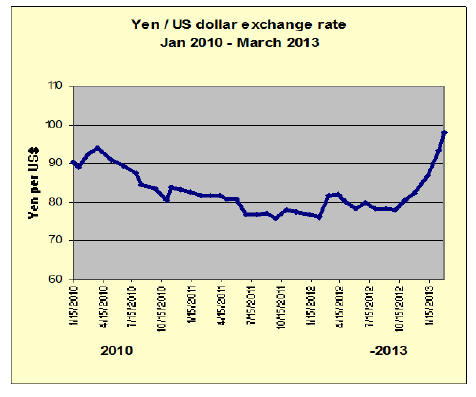
However, every fall in the value of the yen pushes up the
cost of imported fuel and this poses a risk to domestic
demand as almost all fuel is imported. Almost all nuclear
reactors in Japan have been shut down for safety checks
after the recent disaster and power generation depends
entirely on imported fuel.
For a sustained weakening of the yen there would need to
be decisive moves by Japanese institutional investors to
start buying higher-yielding assets. Some hints that this
has begun as the yield on some European bond yields have
fallen.
Weak yen impacts Eurozone prompting calls for EU
growth strategy
The Japanese yen had, by the end of this month, fallen by
more than 20% against the euro and, while Japan accounts
for just 4-5% of trade in the EU, cheaper exports from
Japan are undermining the competitive position of EU car
makers and heavy machinery makers amongst others.
To compete, EU manufacturers are faced with having to
reduce market sales prices and some analysts are openly
talking of a price war in the EU.
In a market which is burdened by austerity policies lower
priced imports such as those now available from Japan
weaken domestic EU companies who are now calling for
more growth friendly policies to combat EU deflation.
OECD lends support to Japan’s economic policies
Critics of „Abenomics‟, the term coined to describe
Japan‟s bold economic policies, are trying to decide if this
will aid global economic recovery or just create a shortterm
boost to the economy.
An OECD press release introducing the latest OECD
Economic Survey of Japan provides the organization‟s
view of prospects for the Japanese economy.
Overall, the OECD is supportive of the moves taken by the
Japanese government and central bank but warns; “ Japan
is poised for an economic expansion, but long-term growth
prospects remain contingent on additional efforts to
revitalise the economy and reduce unsustainable levels of
public debt.”
The new Survey, presented in Tokyo by OECD Secretary-
General Angel Gurría, forecasts the Japanese economy
will grow by about 1.5% annually in 2013 and 2014.
For the press release see:
http://www.oecd.org/newsroom/japan-is-poised-forexpansion-
but-must-curb-government-debt.htm
The press release says “Japan‟s gross public debt reached
220% of GDP in 2012, the highest level ever recorded in
the OECD area, while the budget deficit is hovering
around 10% of GDP.
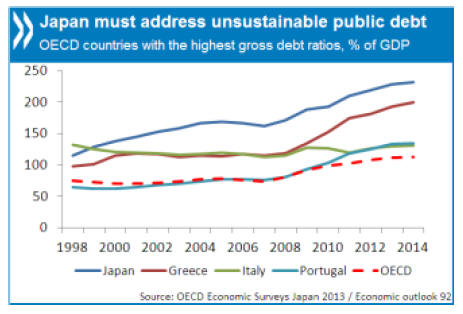
With the debt ratio moving further into uncharted territory,
the report underlines the urgent need to restore fiscal
sustainability.
The sustainability of public finances is a major concern
but that the medium-term fiscal plan that the government
has promised to present later this year should include
spending cuts and tax increases large enough to bring the
budget back into primary surplus by 2020 and stabilise the
public debt ratio.”
A detailed and credible package is essential to maintain
market confidence in Japan's fiscal situation, mitigating
the risk of a run-up in long-term interest rates says the
OECD.
Trade news from the Japan Lumber Reports (JLR)
The Japan Lumber Reports (JLR), a subscription trade
journal published every two weeks in English, is
generously allowing the ITTO Tropical Timber Market
Report to extract and reproduce news on the Japanese
market.
The JLR requires that ITTO reproduces newsworthy text
exactly as it appears in their publication.
For the JLR report please see:
http://www.nmokuzai.
com/modules/general/index.php?id=7
Wood supply and demand statistics
The Ministry of Agriculture, Forestry and Fisheries
announced wood demand and supply statistics of 2012.
Total demand was 24,650 M cbms, 0.3% up. In wood
supply, domestic wood was 18,470 M cbms, 1.0% up.
Imported wood was 6,177 M cbms, 1.6% down so that
share of domestic wood was 74.9%, 0.5 points up from
2011.
Wood demand in 2012 (log shipment volume to sawmills,
plywood mills and chipping plants) was almost unchanged
from 2011. Both sawmills and plywood mills‟ demand
dropped some from 2011 but the volume for wood chip
plants increased.
Housing starts were 882,797 units in 2012, 5.8% more
than 2011 but plywood mills curtailed the production by
over supply in 2011 with rush orders after the North East
Japan Earthquake in March 2011, which reduced wood
consumption in 2012.
Domestic logs for plywood use were 2,602 M cbms, all
time high record.
In imported wood, North America and New Zealand
increased but import from Russia and South Sea Asia
significantly decreased in 2012.
Number of sawmills in 2012 was 5,927, 315 mills or 5%
less than 2011. Number of sawmills in 2002 was 10,394 so
it dropped by almost half in ten years.
Shipment of lumber in 2012 was 9,302 M cbms, 1.4% less
than 2011 out of which kiln dried lumber was 2,744 M
cbms, 4.3% more.
Tropical logs
Rainy season in Malaysia is almost over but Sarawak still
has foul weather and log production remains low.
Local plywood mills are aggressively buying logs to run
the mills steadily.
India has resumed log purchase again since last month.
Thus, supply and demand of logs are badly imbalance so
the log suppliers continue asking higher prices.
Sarawak meranti regular prices are $280 per cbm FOB or
higher, more than $10 up from previous contract.
Shipment for Japan is down to one shipment in two
months after many South Sea log peeling plywood mills
are gone.
Log inventories are over three months now so that they
procure minimum volume only.
Meranti small prices are about $240, $10 up. Sabah kapur
regular prices are firming at about $365.
China buys PNG logs actively so that log prices are
climbing. For Japan market, callophylum prices are $290,
$10 up. Mersawa is $280-290 and MLH is $185, $20 up.
Log prices in Japan are firm due to weak yen. Meranti
regular log prices are 8,800 yen per koku CIF, 500 yen up
from March. Log prices will be higher in coming months
by higher FOB and weak yen so plywood mills asked 20%
price hike on plywood.
since last February but the hike so far is only less than
10%.
Market for imported tropical plywood
The suppliers in the South East Asia continue asking
higher export prices. In Malaysia, weather remains
unstable yet and log production is low so that the log
prices are gradually increasing.
Plywood mills‟ production is inactive so that the order
balances keep swelling up. With higher log cost and
climbing labor cost, plywood mills are asking higher
plywood prices.
Meantime, the yen is getting weaker so the largest
exporting plywood mill closed up April delivery of JAS
concrete forming 3x6 at 52,000 yen per cbm C&F and has
started asking 55,000 yen now. The price was 40,000 yen
in December last year so this is real steep hike.
In Japan, movement of imported plywood is momentarily
resting so that sharp price increase is difficult. Therefore,
importers are cautious to commit high priced future
cargoes until higher prices are accepted in the market.
The importers are restraining both purchase and sales now.
Actually they seem to wait until actual demand shows up
and necessity comes up to procure future cargoes. They
can tide over by adjusting the inventories for some time.
By limited supply with higher export prices by the
suppliers, the market prices in Japan are holding so it
looks like confrontation by three parties, suppliers,
importers and distributors continues for some time.
However, the inventories continue declining in Japan with
reduced purchase since last February so there are some
worries about shortage in the market in coming months.
Current market prices in Tokyo on JAS concrete forming
3x6 panel are 1,080-1,100 yen per sheet delivered, 30-50
yen up from March.
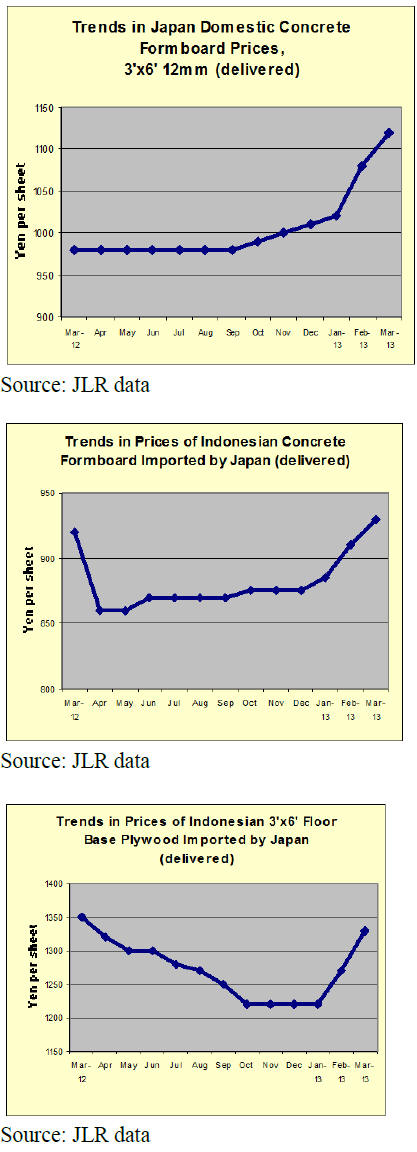
Orders for major house builders in March
March orders were very brisk for major house builders as
more people think this is time to buy. Factors are future
hike of mortgage interest rate, recovery of stock market,
coming raise of consumption tax and higher house prices
in future by materials inflation by weakening yen.
However, for house builders, works have been delayed by
shortage of carpenters and craftsmen and some builders
notify customers it would take time to complete.
Sekisui House had active orders in March. Orders for
detached units increased by 7% compared to March last
year. Rental units were up by 26% and units built for sale
were up by 34% but condominiums and renovation
business were down so overall house business was up by
10%.
Daiwa House had 4% more orders for detached unit, five
consecutive months increase. Units built for sales were up
by 49% so overall housing business including property
trading was up by 16%.Condominium sales and
renovation business were down by 9% and 5%.
Sumitomo Forestry had 4% more orders for detached
custom made units. Sales of environmentally friendly
houses and units for rebuilding have been steady.
Misawa Home had 8% more orders on detached units in
March, out of which custom made units were 7%, units
built for sale were 18% and rental units were 14% up,
making overall house business increase of 9%. Mitsui
Home‟s custom made units increased by 25%.
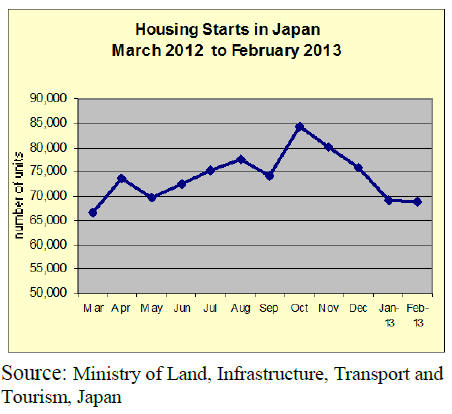
For the complete housing data see the Construction
Research and Statistics Office
Policy Bureau, Ministry of Land, Infrastructure, Transport
and Tourism website at:
http://www.mlit.go.jp/toukeijouhou/chojou/stat-e.htm
Japan’s furniture imports
January 2013 furniture imports
The source and value of Japan‟s office, kitchen and
bedroom furniture imports for March 2013 are shown
below. Also illustrated is the trend in imports of office
furniture (HS 9403.30), kitchen furniture (HS 9403.40)
and bedroom furniture (HS 9403.50) between 2009 and
March 2013.
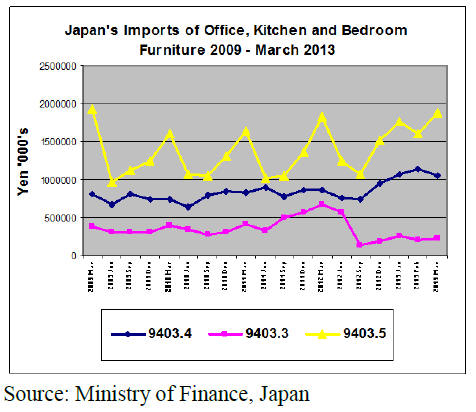
Office furniture imports (HS 9403.30)
In March 2013 three countries provided more than half of
the total office furniture imports by Japan.
The combined total of imports from the top three
suppliers, China Poland and Italy in March amounted to
yen 133 bil. or 57% of total office furniture imports.
Imports from China rose 35%, those from Poland fell 23%
while imports from Italy jumped around 70%.
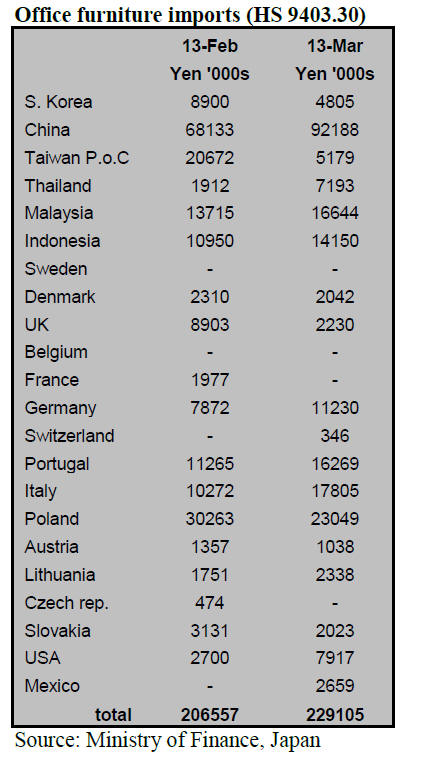
The other major suppliers were Malaysia and Indonesia
which, together added a further 13% to the total trade in
office furniture.
In March, Japan‟s total office furniture imports totaled yen
229 bil up 11% from February. It is interesting to note that
Vietnam does not feature as a top 20 supplier of office
furniture to Japan despite being a major supplier of kitchen
and bedroom furniture to the Japanese market.
Kitchen furniture imports (HS 9403.40)
Kitchen furniture imports remain the second largest
segment of all wooden furniture imports into Japan after
bedroom furniture.
Vietnam maintained its number one position as the
supplier of kitchen furniture to Japan in March and the
value of imports from Vietnam were largely unchanged
from February at yen 400 bil.
The top five suppliers of kitchen furniture accounted for
over 90% of all kitchen furniture imports. Vietnam
supplied yen 400 bil. (unchanged in March), China yen
215 bil. (up 16%), Philippines yen 148 bil. (down 12%),
Indonesia yen 147 bil. (down 34%) and Malaysia yen 56
bil. (up 6%). Total imports of kitchen furniture in March
were yen 1,049.9 bil ., down from yen 1140.8 bil in
February, an 8% decline.
The US and Canada feature as suppliers of kitchen
furniture but in March both experienced a fall in Japanese
imports. US sales were down 45% while Canadian sales to
Japan were down around 37%.
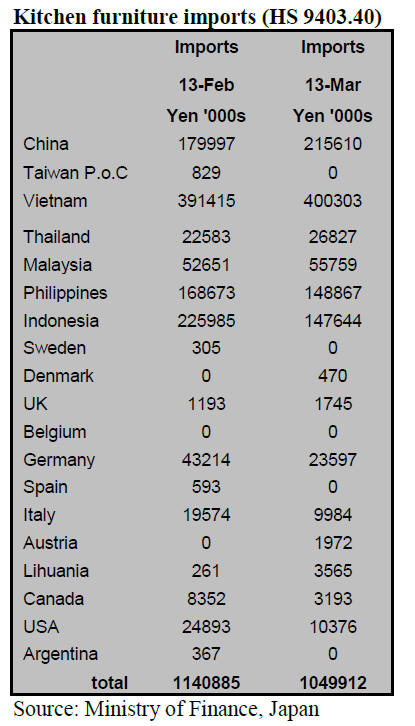
Bedroom furniture (HS 9403.50)
The value of Japan‟s bedroom furniture imports in March
2013 rose 18% from a month earlier, from Yen 1.6 bil. to
Yen 1.9 bil.
As in February this year the top suppliers were China and
Vietnam which together accounted for around 75% of all
wooden bedroom furniture imports to Japan.
Imports from China during March increased 20% and
imports from Vietnam increased around 8%. Other
countries supplying over yen 40 mil. include Malaysia,
Taiwan P.o.C, Thailand and Indonesia.

|